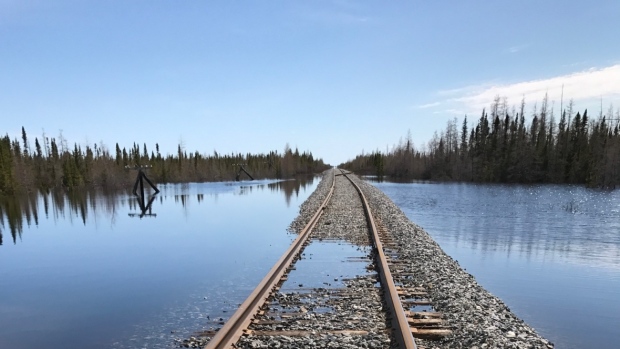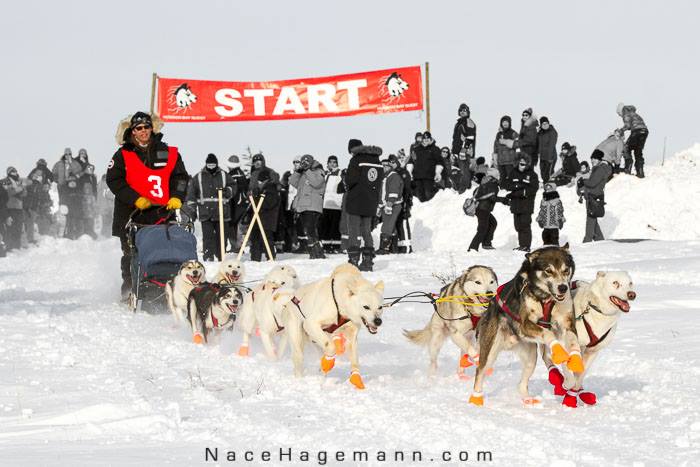by Steve Selden | Mar 2, 2018 | Churchill News

The HBRC will be solely responsible for any damages and costs to repair the rail line. Omnitrax photo.
The parent company of Hudson Bay Railway Company (HBRC), US-based Omnitrax, is off the hook for any damages lost in a pending lawsuit. HBRC will be solely responsible to the federal government if they are found liable for not repairing the washed out rail-line that links Churchill with the south of Manitoba. In May 2017 the tracks were washed away in nearly 20 locations rendering the stretch of tracks useless until millions of dollars are allocated for repair.
Omnitrax’s claim that HBRC is a separate entity has been upheld and thus the Federal Government of Canada has removed its name from the lawsuit.
Soon after two late spring blizzards began to melt, the tracks suffered severe damage in multiple locations. Omnitrax, based in Denver, Colorado, refused to spend an assessed $60 million for repairs. The company claimed economic hardship with regards to the project and was faced with the federal government threatening to sue after the 30-day start deadline elapsed.
The government filed a lawsuit this past November naming Omnitrax and HBRC as defendants. Under a 2008 agreement, Transport Canada indicated that Omnitrax was responsible for keeping the railway running through 2029. As a result, the lawsuit is seeking to recoup $18 million that was an original part of the terms to operate the port and rail line. However, the company has claimed the damages resulted from unforeseeable circumstances or “act of God” thus releasing them from their obligation to repair under their contract with the government.
Omnitrax counsel Jamie Kagan acknowledged that the Attorney General of Canada and Omnitrax have agreed to remove the parent company’s name from the lawsuit and relieve them from any judgment for damages. Any fault and levy of damages will now only be filed against HBRC.
“Our view has always been that this is a political action mainly brought for the purposes of PR and not for a legal remedy, and it appears that the Government of Canada, when pushed, ultimately agreed and has withdrawn the allegations against Omnitrax Inc.,” Kagan said in an interview after the hearing.
“As the private owner of the line, Hudson Bay Railway Company -which also conducts business under the name OmniTRAX Canada- had the obligation to repair the rail line when it was damaged,” a spokesperson for Transport Canada said in an emailed statement.
Churchill residents and business people have been faced with increasing costs for everyday supplies as most now are transported by air. Government subsidies have deferred costs to some extent though some residents have been forced to relocate to Winnipeg or other locations as a result.
Omnitrax is still trying to work out a purchase and sale agreement with a group comprised of northern Manitoba First Nations. Those talks have stalled since the disaster last spring.
by Steve Selden | Feb 26, 2018 | Churchill News

The deMeulles Auto Gas Bar in Churchill reflects the price of gas prior to the rail line washout. Dale deMeulles photo.
Churchill’s gas prices have been reduced by fifty cents a litre thanks to the federal government accessing the economic stimulus fund once again. With petrol prices nearing the $10/gallon mark, this latest reprieve will keep the cost at about $8/gallon. And we complain about gas prices when they reach $3/gallon or more? Kind of puts things in perspective a little, eh?
With federal findings of a probe of Omnitrax, owner of the Port of Churchill facility and the defunct Hudson Bay Line, due to be released soon, residents are enduring rising prices and increased isolation leading to economic strife.
Last week, Natural Resources Minister Jim Carr confirmed that the Ottawa government would allocate $132,870 for Exchange Petroleum to lower gasoline prices to prior levels before the Hudson Bay Rail Line was devastated by flooding last May. Shipping on the railway was the only way to keep costs for supplies and fuel low. Now, ten months later, the pressure is causing long-time residents to move south in search of a more affordable lifestyle.
In September 2016, Ottawa approved the Churchill and Region Economic Development Fund, intended for the diversification of northern Manitoba’s economy following Omnitrax laying off most of the port’s workforce that summer. Businesses have benefitted from the money by offsetting rising shipping costs of materials shipped by barge or airplane.
Last December Carr visited Churchill and announced the government would add $2.7 million to the existing $4.6 million relief fund. After seemingly turning a blind eye to the issue the federal government now is coming to the rescue.
The new windfall of cash will be transferred to Exchange Petroleum, owner of the Calm Air fuel-storage tanks located at the Churchill airport. These tanks are being used due to issues with the port’s storage tanks related to the viability of winter storage of the fuel.

Churchill Port tank farm is unable to store fuel for the town through the winter. Churchill Tank Farm photo.
“This project is a great example of how collaboration and partnerships can help lessen Churchill’s acute economic hardships, restore a quality of life, and keep its entrepreneurs in business,” Exchange CEO Gary Bell wrote in a statement.
Churchill Mayor Mike Spence expressed thanks to Ottawa for its leadership and funding while conveying optimistic thoughts that rail line repairs would commence in the spring.
“This announcement means real savings for residents and businesses of Churchill during these difficult economic times,” Spence wrote. “It’s important to also give a great deal of credit to Exchange Petroleum who stepped in last fall.”
by Steve Selden | Feb 13, 2018 | Churchill News

Veronica Puskas’ quilt Pillars of Strength. Canadian Quilters’ Association photo.
Veronica Puskas, a former resident of Nunavut’s Kivalliq region, recently won an award for Excellence in Work by a first-time exhibitor Quilt in St. Catharines, Ont. at Canada’s national juried show.
Pillars of Strength, is based on a 1950 photograph of her grandmother and mother near the Meliadine River by Rankin Inlet.
The quilt honors her grandmother, Puskas says, though making it also helped her to deal with some heavy emotions.

Veronica Puskas uses Nunavut and the north as inspiration for her quilts and art. Veronica Puskas photo.
“I hope to encourage people that are going through difficult times that through doing some artwork or doing something to make something beautiful is very cathartic,” she says. “It helps you deal with the emotions and the hurt while doing it.”
Puskas says the project, which she began years ago and selected from over 80 entries, was truly a labor of love and family tribute.
“Mom used to tell us you can do better than that and that’s all I kept hearing.”
Chair of the event, Marilyn Michelin,says Puskas’ skill is outstanding.
“To do people in a picture is just unbelievable,” she says. “The talent that people have for that.”
Puskas, who now lives in Niagara-on-the-Lake, Ontario, will continue to use the north and particularly Nunavut as her inspiration for future quilting projects.
by Steve Selden | Feb 8, 2018 | Churchill News

Rankin Inlet in a deep freeze of -60C a couple of days ago. Susan Enuaraq photo.
Rankin Inlet, Nunavut gets cold in the winter. Located on the northwestern shore of the Hudson Bay at 62 degrees and between Chesterfield Inlet and Arviat, the town is definitely in a remote yet exposed region. Weather is just a part of life and recently the weather has been colder than cold.
Schools in the south get “snow days” though when you get to the 60-degree latitudes school closures are “cold days”…usually accompanied by some snow as well. When temperatures fall to -60C with the windchill or more than just about everyone will stay home and not risk going outside and expose skin. For the past few days, schools have cautiously remained closed.
“I don’t remember the last time we actually closed due to weather. This is a bit of an extreme,” said Mike Osmond, chair of the Rankin Inlet District Education Authority.
Temperatures are getting to –40 C before the windchill and when the winds are factored in, it feels colder than –60 C.
“You’ve got blustery winds with some of the coldest temperatures that people have ever experienced,” said David Phillips, senior climatologist with Environment Canada, adding that his charts say skin freezes in two minutes at –55 C.
Windchill was expected to reach above -65C in the past couple of days and we are watching the area closely to see how the community fairs with the dangerous cold. Blame for the almost 15 degrees colder than normal temperatures is being placed on the polar vortex, a combination of an aggressive weather system and frigid air temperatures.
Elders in the Arviat and Rankin region are advising native hunters to remain home until the chill breaks. Living on the land in the past didn’t have this luxury as they had to scavenge for food in even the most dangerous conditions. Grocery stores in these communities of nearly 2,500 people now allow for a community to survive the winter and feel secure in the far north. These towns in the remote northern region do pay high prices for this luxury but there is no other way to survive as a flourishing community.
However, now that people can go to the grocery store, they don’t have to risk their lives hunting in extreme temperatures. Replacing cultural traditions, however, can sometimes be hard for natives to the region used to living off the land and some have gotten themselves into risky situations.
December through February is the coldest time of the year in Rankin Inlet and the urge to get outdoors is always there. However, for many just relaxing inside until the treacherous temperatures rise is sometimes a matter of life or death!
by Steve Selden | Jan 23, 2018 | Churchill News

Dave Daley leaving the start in Churchill. Nace Hageman photo.
For a second consecutive year the Hudson Bay Quest dog sled race, that runs from Churchill to Gillam every March, has been canceled. The ongoing saga of a washed out train line, known as the Hudson Bay Line, after runoff from two late-season blizzards in 2017 has again wreaked havoc on the region’s lifestyle. Without the train line to transport dogs and supplies for mushers, the expenses would be too steep for those wanting to compete.
“Normally what would happen was we would have our sponsors bring the mushers’ dog teams either to Churchill or from Churchill, depending on which direction the race was going,” said Bill Dingwall, Hudson Bay Quest committee chair.
“But this year, without the train, we couldn’t guarantee that the teams would either be able to get to the start or the finish, or home from the finish.”
The alternative would be returning by land with the dog teams after the race finishes and the cost for most mushers would be prohibitive
“That was quite a daunting task for a lot of the mushers and it would have cost them a lot more money,” said Dingwell.
“Once we put out that you’d be on your own to get to the start and home after the finish, I think it was an easy decision for a lot of the guys.”
Last year the Quest was canceled as well by one of the severe blizzards that buried the open tundra and made the trail too treacherous to run the dog teams.
“We were very disappointed last year because it was such a last minute decision to cancel,” he said. “This year we knew going in not having a rail line was going to be extremely hard to do with logistics of moving mushers, moving handlers, moving even our race marshal, our vets, and everybody … It wasn’t safe to do it, honestly.”
The Hudson Bay Quest is well known among the heartiest mushers as one of the most challenging races in North America. it annually draws mushers from all over the world and some use it as a stepping stone to bigger races such as the Iditarod and the Yukon Quest. On a smaller scale, mushers are self – sufficient out on the land just like those races.
“It’s not as long [as others] but it’s a hard race … It’s so hard that if you finish the race, you get your registration money back. Doesn’t matter when you finish, we have a timeline, but if you finish we give your registration money back just because it’s that much of an accomplishment, we feel.”
In a “normal year”, which in the north such a phrase carries a completely different meaning, the Quest will draw from 12 – 16 mushers and dog teams. This year only four had entered this far and three of those opted to defer their registration fees to next years event with the hope that the train line will be repaired and the region will be back in business. A decision to only proceed this year if a minimum of six racers entered was made early on. With the deadline to enter looming race organizers officially pulled the plug on this one.
The race has been an iconic event for the region for a long time and once the rail line is repaired it will happen again. Churchill, in particular, has suffered extensively from the lack of train service. The polar bear season was a needed boost to the morale and economy of the town but a long-term solution is needed. Town officials expect news soon on the transfer of the port and accompanying rail line and the future of the Hudson Bay Quest. Stay posted to our site for upcoming news on the ongoing drama in the north!
by Steve Selden | Jan 6, 2018 | Churchill News

Festivities at the Inuvik Sunrise Festival in 2012. Inuvik Phil photo.
The sun will rise today in Inuvik, NWT for the first time since December 5th. The celebration will be rejoiced by the 3,300 townsfolk and hundreds of travelers during the weekend’s 31st Annual Inuvik Sunrise Festival to honor the return of light to the region.
An ice village in the Twin Lakes area has been constructed as the main attraction and will feature igloos,sculptures, a teepee and an expanded sliding hill for kids to enjoy. Three days of fun and celebration will occur mainly in the Midnight Sun and Twin Lakes districts.
“Hibernation time” is how Kylik Kisoun-Taylor, Owner of Tundra North Tours, describes the sun -lees period leading up to the reemergence. The continuous 24 – hour darkness is in stark contrast to the non-stop daylight in the summer.
“I feel like this town really shuts down. The restaurants aren’t as busy, everyone is really recuperating, and then once the sun comes out, everyone comes back alive.”, states Kisoun – Taylor.
Relatives of resident families and loved ones also return for visits at this uplifting time of year. It’s a celebration of life itself.

Sunrise in Inuvik. Town of Inuvik photo.
“It’s really nice to see because you want to show off where you live and what better time to show it off than when there is all of this great stuff to look, at a festival, bonfire and fireworks.” says Mackenzie Chauvin who took advantage of an airline discount to visit his cousin.
“They started talking to us about the sunrise festival and the darkness and that it’s really just a good time to get an authentic visit to see what Inuvik’s about.”, states Chauvin.
Canadian North and Air North are both offering discounted tickets for travelers jorneying to Inuvik for the festival.

Drum dancing at the Inuvik Sunrise Festival. Lu North photo.
Chris Sharpe, Inuvik’s marketing and communications coordinator, is enjoying his first northern winter. He is proud to announce some new activities this year, such as a concert by well-known Canadian musician and songwriter, Norman Foote, .as well as a dance party and DJ workshop. Drum dancing and vendors from local eateries will kick off the festival.
“I recommend it to everybody. If you live on this earth, you should try everything at least once. I’m really glad I experienced it, and I’m super excited the sun is coming back,” he laughed.

















